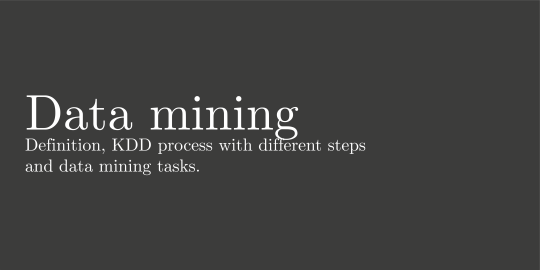Text
Data mining

1.What's Data mining ?
Datamining is the process of extracting and discovering patterns in large datasets involving methods at the intersection of machine learning, statistics and database systems. Datamining is interdisciplinary subfield of computer-science and statistics with overall goal of extracting information (with intelliegent methods) from a data set and transforming the information into a comprensible structure for further use. Data mining is the analysis step of The KDD process "Knowledge discovery in database".
2.What's KDD process ?
KDD process is known as "Knowledge Discovery in Database".It"s a multi-step process of finding knowledge from large data sets and emphasizes the high-level application of particular datamining methods.It's of interests to researchers in machine learning, pattern recognition, databases, ststistics, artificial intelligence, knowledge aquisition for experts systems and data-visualization. The picture below defines the different steps of KDD process and each of those steps have an input and output entity. The KDD process can't be executed without beginning on data.

3.What are the different steps of the KDD process ?
The overall process of finding and interpretting patterns from data involves the repeated application of the following steps mentioned in the graph above :
Selection : we create a target data set by seecting a part of the overall data set as a sample then focusing on a subset of variables on which discovery is to be performed. The result of these step is a subset of data considered as a sample.
Preprocessing : These step of the KDD process takes the target data set as an input then it applyes data cleaning by removing the noise from the input data set then restucturing the data set. The output of these operation is a preprocessed dataset that can be able to be transformed in the next step.
Data transformation : These step takes the preprocessed data as input and tres to find some useful features depending on the goal of the task and reducing dimension to execute an effective learining datamining.
Data mining : in this phase we will descide whether the goal of KDD process is classification, regression, clustering ...etc. Discover the patterns of interests.
Interpretation : Interpretating mined patterns and consolidating discovered knowledge.
4.What are data mining tasks ?
There are several steps that are defined in the sub-process of KDD especially in datamining steps. In Data mining, there are 02 types of data mining that are :
Predictive mining: predective data mining is the analysis done to predict a future event or other data or trends and to predict something will happen in the near future. Predective data mining offers a better future analysis and to make better decisions to add a value in predective analytics like for example predecting the future customer of a defined service, define the future price of oil and gaz in the world market, define the next ill of an international pandemic, define the future political conflict ... etc. There are 4 types of descriptive data mining tasks which are :
Classification analysis : It is used to retrieve critical and pertinent data and metadata. It categorizes information into various groups. Classification Analysis is best demonstrated by email providers. They use algorithms to determine whether or not a message is legitimate.
Regression Analysis : It tries to express the interdependence of variables. Forecasting and prediction are common applications.
Time Serious Analysis : It is a series of well-defined data points taken at regular intervals.
Prediction Analysis : It is related to time series, but the time isn’t restricted.
Descriptive mining : descriptive data mining is to describe data and make data more readable to human beings, it's used to extract information from previous events and data and to discovering an interesting patterns and association behind data. It's also used to exract correlations, relationships between features and finding new laws and regularities based on data. There are four different types of Descriptive Data Mining tasks. They are as follows :
Clustering analysis : It is the process of determining which data sets are similar to one another. For example, to increase conversion rates, clusters of customers with similar buying habits can be grouped together with similar products.
Summerazation analysis : It entails methods for obtaining a concise description of a dataset. For example, summarising a large number of items related to Christmas season sales provides a general description of the data, which can be extremely useful to sales and marketing managers.
Association rules analysis : This method aids in the discovery of interesting relationships between various variables in large databases. The retail industry is the best example. As the holiday season approaches, retail stores stock up on chocolates, with sales increasing before the holiday, which is accomplished through Data Mining.
Sequence discovery analysis : It's all about how to do something in a specefic order. For instance, a user may frequently purchase shaving gel before purchasing razor in a store.It all comes down to the order in which the user purchases the product, and the store owner can then arrange the items accordingly.
5.Links :
3 notes
·
View notes
Text
LaTeX
Hello, this post talks about LaTeX document preparation system used for creating mathematical formulas and used by students and researchers in the academic environment. The slides below shows how to set up and use LaTeX easily and without issues.


















0 notes
Text
Matplotlib
Hello, this blog is written by Ahmed Ferradj, This blog talks about Matplotlib library, it's a libary that allows to visualize data without any issues.The slides below shows how to use it.



















1 note
·
View note
Text
Pandas
Hello, in this blog you will learn how to use Pandas, install pandas and dosome data science in Pandas Python Library.















1 note
·
View note
Text
Numpy
Hello, this blog post talks about Numpy, Numpy is a Python library for manipulating arrays and it's used in Data analytics and Data Science.
The slides below show how to install and use Numpy.





















1 note
·
View note